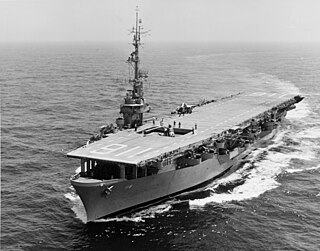
USS Badoeng Strait was a Commencement Bay-class escort carrier of the United States Navy during the Korean War. The Commencement Bay class were built during World War II, and were an improvement over the earlier Sangamon class, which were converted from oil tankers. They were capable of carrying an air group of 33 planes and were armed with an anti-aircraft battery of 5 in (127 mm), 40 mm (1.6 in), and 20 mm (0.8 in) guns. The ships were capable of a top speed of 19 knots, and due to their origin as tankers, had extensive fuel storage.
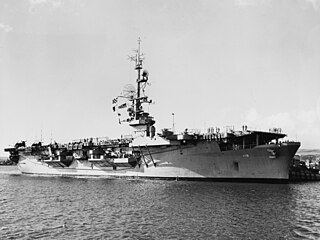
USS Bairoko was a Commencement Bay-class escort carrier of the United States Navy in service from 1945 to 1955. The Commencement Bay class were built during World War II, and were an improvement over the earlier Sangamon class, which were converted from oil tankers. They were capable of carrying an air group of 33 planes and were armed with an anti-aircraft battery of 5 in (127 mm), 40 mm (1.6 in), and 20 mm (0.8 in) guns. The ships were capable of a top speed of 19 knots, and due to their origin as tankers, had extensive fuel storage.

USS Rabaul was a Commencement Bay-class escort carrier of the United States Navy. The Commencement Bay class were built during World War II, and were an improvement over the earlier Sangamon class, which were converted from oil tankers. They were capable of carrying an air group of 33 planes and were armed with an anti-aircraft battery of 5 in (127 mm), 40 mm (1.6 in), and 20 mm (0.8 in) guns. The ships were capable of a top speed of 19 knots, and due to their origin as tankers, had extensive fuel storage. She was delivered on 30 August 1946, but never commissioned. After spending 26 years in reserve, she was scrapped in 1973.
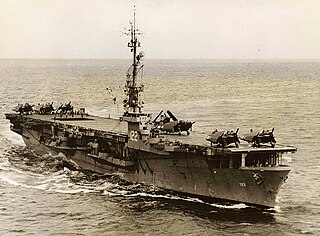
USS Palau was a Commencement Bay-class escort carrier of the United States Navy. The Commencement Bay class were built during World War II, and were an improvement over the earlier Sangamon class, which were converted from oil tankers. They were capable of carrying an air group of 33 planes and were armed with an anti-aircraft battery of 5 in (127 mm), 40 mm (1.6 in), and 20 mm (0.8 in) guns. The ships were capable of a top speed of 19 knots, and due to their origin as tankers, had extensive fuel storage.

USS Tinian was a Commencement Bay-class escort carrier of the United States Navy. The Commencement Bay class were built during World War II, and were an improvement over the earlier Sangamon class, which were converted from oil tankers. They were capable of carrying an air group of 33 planes and were armed with an anti-aircraft battery of 5 in (127 mm), 40 mm (1.6 in), and 20 mm (0.8 in) guns. The ships were capable of a top speed of 19 knots, and due to their origin as tankers, had extensive fuel storage.

USS Mindoro was a Commencement Bay-class escort carrier of the United States Navy. The ship was a converted oil tanker, and she had a capacity to carry up to thirty-three aircraft. She was built during World War II, but was completed too late to see action during the conflict. She nevertheless saw service with the 8th Fleet in the late 1940s and early 1950s in the Atlantic Ocean. She also made two deployments to the Mediterranean Sea, in 1950 and 1954, before being decommissioned in January 1955 and assigned to the Atlantic Reserve Fleet. She was retained for just four years before being struck from the naval register in December 1959 and thereafter scrapped.

USS Point Cruz was a Commencement Bay-class escort carrier of the United States Navy. The Commencement Bay class were built during World War II, and were an improvement over the earlier Sangamon class, which were converted from oil tankers. They were capable of carrying an air group of 33 planes and were armed with an anti-aircraft battery of 5 in (127 mm), 40 mm (1.6 in), and 20 mm (0.8 in) guns. The ships were capable of a top speed of 19 knots, and due to their origin as tankers, had extensive fuel storage.

USS Saidor was a Commencement Bay-class escort carrier of the United States Navy. The Commencement Bay class were built during World War II, and were an improvement over the earlier Sangamon class, which were converted from oil tankers. They were capable of carrying an air group of 33 planes and were armed with an anti-aircraft battery of 5 in (127 mm), 40 mm (1.6 in), and 20 mm (0.8 in) guns. The ships were capable of a top speed of 19 knots, and due to their origin as tankers, had extensive fuel storage.

USS Sicily was a Commencement Bay-class escort carrier in the United States Navy. The Commencement Bay class were built during World War II, and were an improvement over the earlier Sangamon class, which were converted from oil tankers. They were capable of carrying an air group of 33 planes and were armed with an anti-aircraft battery of 5 in (127 mm), 40 mm (1.6 in), and 20 mm (0.8 in) guns. The ships were capable of a top speed of 19 knots, and due to their origin as tankers, had extensive fuel storage.

USS Commencement Bay (CVE-105), the lead ship of her class, was an escort carrier of the United States Navy. The Commencement Bay class were built during World War II, and were an improvement over the earlier Sangamon class, which were converted from oil tankers. They were capable of carrying an air group of 33 planes and were armed with an anti-aircraft battery of 5 in (127 mm), 40 mm (1.6 in), and 20 mm (0.8 in) guns. The ships were capable of a top speed of 19 knots, and due to their origin as tankers, had extensive fuel storage. Commencement Bay was employed as a training ship during the war, training new crews for the other members of her class as they were completed. She saw no active service after the war ended in 1945, instead being assigned to the Pacific Reserve Fleet, and was eventually sold for scrap in 1972.
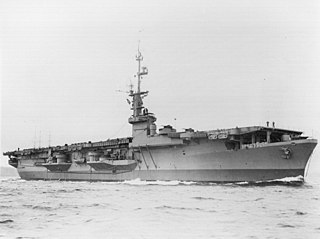
USS Cape Gloucester was a Commencement Bay-class escort carrier of the United States Navy, in service from 5 March 1945 to 5 November 1946. The Commencement Bay class were built during World War II, and were an improvement over the earlier Sangamon class, which were converted from oil tankers. They were capable of carrying an air group of 33 planes, and due to their origin as tankers and were armed with an anti-aircraft battery of 5 in (127 mm), 40 mm (1.6 in), and 20 mm (0.8 in) guns. The ships were capable of a top speed of 19 knots, had extensive fuel storage. After spending another 25 years in the reserve fleet, the ship was scrapped in 1971.

USS Block Island was a Commencement Bay-class escort carrier of the United States Navy. The Commencement Bay class were built during World War II, and were an improvement over the earlier Sangamon class, which were converted from oil tankers. They were capable of carrying an air group of 33 planes and were armed with an anti-aircraft battery of 5 in (127 mm), 40 mm (1.6 in), and 20 mm (0.8 in) guns. The ships were capable of a top speed of 19 knots, and due to their origin as tankers, had extensive fuel storage.

USS Gilbert Islands was a Commencement Bay-class escort carrier of the United States Navy. The Commencement Bay class were built during World War II, and were an improvement over the earlier Sangamon class, which were converted from oil tankers. They were capable of carrying an air group of 33 planes and were armed with an anti-aircraft battery of 5 in (127 mm), 40 mm (1.6 in), and 20 mm (0.8 in) guns. The ships were capable of a top speed of 19 knots, and due to their origin as tankers, had extensive fuel storage.

USS Kula Gulf was a Commencement Bay-class escort carrier of the United States Navy. She was originally named Vermillion Bay, but was renamed during construction. The Commencement Bay class were built during World War II, and were an improvement over the earlier Sangamon class, which were converted from oil tankers. They were capable of carrying an air group of 33 planes and were armed with an anti-aircraft battery of 5 in (127 mm), 40 mm (1.6 in), and 20 mm (0.8 in) guns. The ships were capable of a top speed of 19 knots, and due to their origin as tankers, had extensive fuel storage.

USS Salerno Bay was a Commencement Bay-class escort carrier built by Seattle-Tacoma Shipbuilding Corporation for the United States Navy during World War II. The Commencement Bay class were built during World War II, and were an improvement over the earlier Sangamon class, which were converted from oil tankers. They were capable of carrying an air group of 33 planes and were armed with an anti-aircraft battery of 5 in (127 mm), 40 mm (1.6 in), and 20 mm (0.8 in) guns. The ships were capable of a top speed of 19 knots, and due to their origin as tankers, had extensive fuel storage.
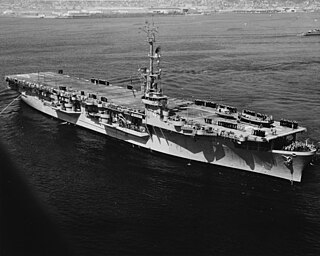
USS Rendova was a Commencement Bay-class escort carrier of the United States Navy. The Commencement Bay class were built during World War II, and were an improvement over the earlier Sangamon class, which were converted from oil tankers. They were capable of carrying an air group of 33 planes and were armed with an anti-aircraft battery of 5 in (127 mm), 40 mm (1.6 in), and 20 mm (0.8 in) guns. The ships were capable of a top speed of 19 knots, and due to their origin as tankers, had extensive fuel storage.

USS Puget Sound was a Commencement Bay-class escort carrier of the United States Navy. The Commencement Bay class were built during World War II, and were an improvement over the earlier Sangamon class, which were converted from oil tankers. They were capable of carrying an air group of 33 planes and were armed with an anti-aircraft battery of 5 in (127 mm), 40 mm (1.6 in), and 20 mm (0.8 in) guns. The ships were capable of a top speed of 19 knots, and due to their origin as tankers, had extensive fuel storage.

USS Vella Gulf was a Commencement Bay-class escort carrier of the United States Navy, originally named Totem Bay. The Commencement Bay class were built during World War II, and were an improvement over the earlier Sangamon class, which were converted from oil tankers. They were capable of carrying an air group of 33 planes and were armed with an anti-aircraft battery of 5 in (127 mm), 40 mm (1.6 in), and 20 mm (0.8 in) guns. The ships were capable of a top speed of 19 knots, and due to their origin as tankers, had extensive fuel storage.

USS Springfield was a Cleveland-class light cruiser of the United States Navy, which were built during World War II. The class was designed as a development of the earlier Brooklyn-class cruisers, the size of which had been limited by the First London Naval Treaty. The start of the war led to the dissolution of the treaty system, but the dramatic need for new vessels precluded a new design, so the Clevelands used the same hull as their predecessors, but were significantly heavier. The Clevelands carried a main battery of twelve 6-inch (152 mm) guns in four three-gun turrets, along with a secondary armament of twelve 5 in (127 mm) dual-purpose guns. They had a top speed of 32.5 knots.
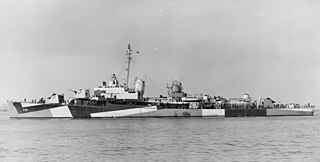
USS Willard Keith (DD-775), an Allen M. Sumner-class destroyer, is currently the only completed ship of the United States Navy ever named for Willard Keith, a United States Marine Corps captain who died in combat during the campaign for Guadalcanal. He was awarded the Navy Cross for his actions.























